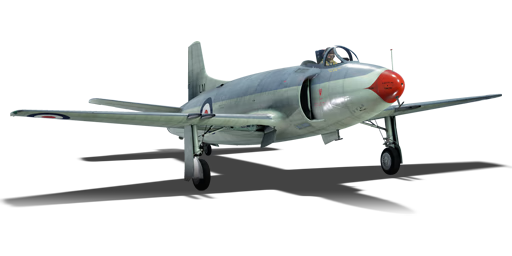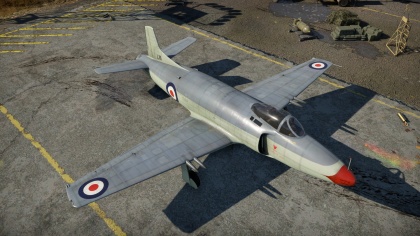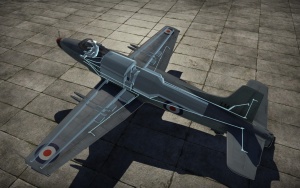Attacker FB 1
Contents
Description
The Attacker FB 1 is a rank British jet fighter
with a battle rating of (AB), (RB), and (SB). It was introduced in Update 1.49 "Weapons of Victory".
Following the Sea Fury in the Fleet Air Arm branch is the first operational carrier-based jet in the Royal Navy's arsenal, the Supermarine Attacker. The Attacker was Britain's first naval jet and offers good all-around performance for a first-generation jet design, as well as a varied ground attack and fighter-bomber capabilities. Available to research after the Sea Fury, the Attacker is a different approach to jet fighter aircraft by comparison to the Meteors, Vampire or Venom.
The most unique and unusual trait of the Attacker is its taildragger configuration and wing-mounted armament. As the wing and undercarriage are shared with another Supermarine aircraft, the Spiteful, the Attacker is the only British jet from its period to feature wing-mounted cannon armament. Unlike other British jet fighters that adopt nose-mounted configurations, the 4 x 20 mm Hispano Mk V cannons on the Attacker do require careful use of convergence as a result of their positioning, much like the Sea Fury and Seafires.
Mounted in pairs with two in each wing, the Hispano cannons have 624 rounds of ammunition, more than the piston fighters before it. The Attacker can also mount 2 x 500 lb or 2 x 1,000 lb bombs as well as 12 x 76 mm RP-3 rockets with the GLBC Mk 3 and GRC Mk 8 modifications respectively. This combined with the universal or ground targets belts allows the Attacker to live up to its namesake, should pilots choose to use it in a fast ground-attack fighter-bomber role.
The unusual undercarriage is also very forgiving during landings, both on airfields and aircraft carriers. However, this can also prove to be a hindrance in simulator mode and for pilots who prefer cockpit view; the aircraft is indeed a taildragger. This results in an extremely restricted view on the ground and while landing, especially on a carrier.
General info
Flight performance
| Characteristics | Max Speed (km/h at 0 m - sea level) |
Max altitude (metres) |
Turn time (seconds) |
Rate of climb (metres/second) |
Take-off run (metres) | |||
|---|---|---|---|---|---|---|---|---|
| AB | RB | AB | RB | AB | RB | |||
| Stock | 885 | 860 | 26.2 | 26.9 | 22.8 | 21.5 | 950 | |
| Upgraded | 936 | 922 | 23.9 | 25.0 | 33.8 | 28.0 | ||
Details
| Features | |||||
|---|---|---|---|---|---|
| Combat flaps | Take-off flaps | Landing flaps | Air brakes | Arrestor gear | Drogue chute |
| ✓ | ✓ | ✓ | ✓ | ✓ | X |
| Limits | ||||||
|---|---|---|---|---|---|---|
| Wings (km/h) | Gear (km/h) | Flaps (km/h) | Max Static G | |||
| Combat | Take-off | Landing | + | - | ||
| 520 | 520 | 351 | ~10 | ~6 | ||
| Optimal velocities (km/h) | |||
|---|---|---|---|
| Ailerons | Rudder | Elevators | Radiator |
| < 491 | < 600 | < 620 | N/A |
Engine performance
| Engine | Aircraft mass | |||||
|---|---|---|---|---|---|---|
| Engine name | Number | Empty mass | Wing loading (full fuel) | |||
| Rolls-Royce Nene-3 | 1 | 4,400 kg | 261 kg/m2 | |||
| Engine characteristics | Mass with fuel (no weapons load) | Max Takeoff Weight | ||||
| Weight (each) | Type | 8m fuel | 20m fuel | 29m fuel | ||
| 930 kg | Centrifugal-flow turbojet | 4,690 kg | 5,120 kg | 5,442 kg | 7,170 kg | |
| Maximum engine thrust @ 0 m (RB / SB) | Thrust to weight ratio @ 0 m (100%) | |||||
| Condition | 100% | WEP | 8m fuel | 20m fuel | 29m fuel | MTOW |
| Stationary | 2,109 kgf | N/A | 0.45 | 0.41 | 0.39 | 0.29 |
| Optimal | 2,109 kgf (0 km/h) |
N/A | 0.45 | 0.41 | 0.39 | 0.29 |
Survivability and armour
- 38 mm Bulletproof glass - Armoured windscreen
- 12.7 mm Steel - Armour plate behind the pilot's seat
Armaments
Offensive armament
The Attacker FB 1 is armed with:
- 4 x 20 mm Hispano Mk.V cannon, wing-mounted (167 rpg inner, 145 outer = 624 total)
Suspended armament
The Attacker FB 1 can be outfitted with the following ordnance:
- Without load
- 2 x 500 lb G.P. Mk.IV bombs (1,000 lb total)
- 2 x 1,000 lb G.P. Mk.I bombs (2,000 lb total)
- 12 x RP-3 rockets
Usage in battles
The Attacker FB 1 is a versatile platform for multiple tasks both in ground and air battles, featuring a competitive armament in air battles and tremendous firepower in ground battles. The main weaponry of the attacker is the 4 Hispanos Mk. V 20mm cannons, capable of doing significant damage to ground and air targets.
When in air battles:
The attacker has multiple roles in air battles: fighter, interceptor, bomber and attacker (unironically). It should be noted that, at 7.0, you will face many prop planes. This is a pro and a con. The Attacker has superb speed, climb rate and flying ceiling than any prop plane you will encounter but it also lacks acceleration, turn speed and it is not a really manoeuvrable plane when dogfighting.
As fighter:
Despite its heavy-weight and lack of manoeuvrability, the attacker excels in boom and zoom attacks, no plane will be able to catch you when doing boom and zoom. Do not engage in turn fights as you will lose a tremendous amount of energy and the acceleration is not great to regain said lost energy, be aware when fighting a target.
As interceptor/bomber hunter:
This should be the main role of the Attacker when there is no need for dogfighting. Its high speed, decent climb rate, superb firepower and superiority at high altitudes make the attacker an excellent bomber hunter. Be aware of jet bombers you may encounter (Ar 234 B-2, Ar 234 C-3, IL-28, etc) as they are able to outrun you most of the time. Some jet bombers, like the IL-28, will have superb defensive firepower which will do significant damage for whoever does not know how to engage them. When facing an IL-28, attack from the sides or from the bottom, do not try to tail him. Your armament is more than enough to cause fatal damage to any bomber you may encounter (He 177 A-5 for example)
As an attacker:
As expected, the Attacker can be used as a strike fighter due to the ordnance it carries (refer to armament category) which can be able of taking pillboxes, AA emplacements, artillery, armoured vehicles, tanks, dive bombers, etc. There is no rule on which armament the attacker should use, it all depends on the pilot's discretion, map, battle rating, etc. It is recommended to use ground targets belts due to the AP ammunition but universal belts may be enough to deal with light armoured vehicles and light pillboxes, leaving the ordnance for heavier and more armoured threats.
As a bomber:
Due to being a jet, it is able to be a lighting strike bomber. This means to fly the attacker in a really low altitude (also known as grass cutting flying) with bombs (1,000 lb G.P. Mk. 1 bombs are recommended for base bombing) with a 2-4 second time fuze. When the attacker is on a base, the pilot should drop the bombs really low to the ground to ensure accuracy as no bombsight is able to be used. It may require practice on how and when to drop the bombs. The 2-4 second fuze makes the plane be able to move to a safe zone away from the blast zone. When no time fuze is set, the attacker will be forced to drop the bombs at a higher altitude or be prompt to be killed in the blast zone with assault fuze.
When in ground battles:
The attacker has only 1 role in ground battles, Close Air Support (CAS). The variety of ordnance is enough to be used in all situations depending on the pilot's discretion. RP-3 are launched in pairs and will disable or destroy even the heaviest armour encountered with a couple of rockets. The con of rockets is that they are hard to be aimed, practice will be required. Bombs, on the other hand, are more lenient when it comes to accuracy as the blast zone is bigger and are able to destroy one or more targets at a time. The con of bombs is that a fuze might have to be added depending on the way the pilot wants to drop them (lighting strike, dive-bombing, etc), they are also heavier than the rockets, making the attacker more vulnerable to anti-air fire and dogfighting.
When it comes to just the 20mm cannons, it should be noted than most of the vehicles the attacker will encounter (Leopard 1, Ru 251, BMP-1, etc) will have a poorly armoured roof which the armour-piercing shells will penetrate. Heavier targets (T-54, T-44, IS-2) will only be able to be killed with suspended ordnance as they will not be able to penetrate the roof.
| Tier | Flight performance | Survivability | Weaponry | ||
|---|---|---|---|---|---|
| I | Fuselage repair | Offensive 20 mm | |||
| II | Compressor | Airframe | GLBC mk.3 | ||
| III | Wings repair | Engine | New 20 mm cannons | ||
| IV | G-suit | Cover | GRC mk.8 | ||
Pros and cons
Pros:
- Powerful armament consisting of 4 x 20 mm Hispano Mk V cannons
- Wide track undercarriage for easier, stable landings
- Ability to land on carriers
- Clear visibility cockpit with good all-round vision
- Good ground strike payloads for multi-role capabilities
- Air brakes
- Good rate of climb
Cons:
- Poor acceleration
- Wing-mounted cannons prove to be lacking when compared to the nose-mounted armament of other jets
- The taildragger gear configuration makes for difficult carrier take-off's and landings, particularly in simulator battles
History
The Attacker was part of the first generation of jet aircraft to enter service with the Royal Navy and had the distinction of being the first operational combat jet on a British carrier. Whilst the Royal Air Force was already equipped with Meteors and Vampires, the Fleet Air Arm fell behind due to the difficulty of operating such a radical new technology from the Navy's existing carriers. This was partially the reasoning the FAA showed interest in the Sea Fury and the later Griffon Seafires as a "make-do" solution.
After trials with the De Havilland Sea Vampire, the Navy wanted a jet aircraft that could be operated from its current ships. Supermarine's failed Spitfire replacement, the Spiteful, was rejected by both the FAA and RAF due to already sufficient stocks of operational piston engine aircraft. However, this led to a jet engine design incorporating the same wing and undercarriage from the Spiteful, along with a tailwheel configuration as a result, and utilized a Rolls Royce Nene jet engine.
This rather primitive and rushed design was operational from 1951; however it had an extremely short career - being taken out of front-line service by 1954. This was primarily due to the aircraft's limitations being a "tail-dragger" that made operating on anything other than the deck of an aircraft carrier problematic because of the jet exhaust. The rear tail wheel only made the already hazardous task of operating a jet on a carrier even more problematic for pilots.
The Attacker quickly became superseded by the Hawker Sea Hawk and De Havilland Sea Venom, both of which were much more modern and refined designs featuring more powerful engines, tricycle undercarriages, and possessing superior performance. The Attacker did, however, serve as the base of Supermarine's first swept-wing jet for the RAF, the Swift, as can be seen by the similarity of the nose and fuselage. It would also lead to the more successful Supermarine Scimitar naval jet fighter in the latter part of the 1950s.
Whilst the Attacker saw no major service and was relatively short-lived from an operational standpoint, it nonetheless holds the distinction of being the very first of a very new breed of carrier-borne aircraft and the first chapter in a rapidly advancing era of aviation evolution.
In-game description
Whilst the world's leading air forces forged ahead with the development of new jet aircraft in the mid to late 1940s, naval aviation was left behind in the piston era due to the as of yet undefeated complexities of successfully operating jet aircraft from aircraft carriers. Whilst purpose-designed naval jet aircraft were still embryonic in Britain, there was at least still some scope for converting land-based jet aircraft.
Supermarine had enjoyed the premium position as the designer and manufacturer of fighter aircraft with the world-beating Spitfire but were now in danger of being left behind by other British aviation companies who had moved ahead with jet fighters. The Supermarine Attacker was originally developed for the RAF as a land-based jet in accordance with Spec E.10/44, with its prototype first flying in July 1946.
Powered by the Rolls-Royce Nene engine and using the laminar flow wing which had been successfully tested on the Spiteful, the Attacker failed to offer any performance advantage over the Meteor or Vampire and so was rejected by the RAF. The Fleet Air Arm, however, saw some potential in the aircraft's navalised prototypes and pursued the design to carrier trials in October 1947.
The first production Supermarine Attacker flew in May 1950 and 800 Naval Air Squadron became the first front line jet fighter squadron of the Royal Navy in August 1951 – although some jet experience had been gleaned from a small number of de Havilland Vampires purchased for just that reason.
Armed with four 20mm Hispano cannon and able to carry eight 60 lb rockets or two 1000 lb bombs, the Attacker was capable of reaching 590 mph at sea level and climbing at 6350 feet per minute. However, the Attacker was a true first-generation jet fighter and was already outclassed by fighters of other nations when it entered service. It served only briefly as a front line fighter, being replaced by the Sea Hawk and Sea Venom from 1954 onwards.
It continued in second-line service with the Royal Naval Volunteer Reserve until 1957 and was also used by the Royal Pakistan Air Force.
Media
Excellent additions to the article would be video guides, screenshots from the game, and photos.
See also
- Ar 234 C-3 - A common enemy of the Attacker at the same 7.0 battle rating, the Ar 234 C-3 has comparable ground-attack capabilities.
External links
| Supermarine | |
|---|---|
| Spitfires | |
| Merlin engine | Spitfire Mk Ia · Spitfire Mk IIa · Spitfire Mk.IIa Venture I · Spitfire Mk IIb |
| Spitfire Mk Vb · Spitfire Mk Vb/trop · Spitfire Mk Vc · Spitfire Mk Vc/trop | |
| Spitfire F Mk IX · Spitfire F Mk IXc · Spitfire F Mk XVI | |
| Spitfire LF Mk IX · Plagis' Spitfire LF Mk IXc | |
| Griffon engine | Spitfire F Mk XIVc · Spitfire F Mk XIVe · Prendergast's Spitfire FR Mk XIVe · Spitfire F Mk XVIIIe · Spitfire F Mk 22 · Spitfire F Mk 24 |
| Export | ▄Spitfire Mk Vb/trop · ▃Spitfire LF Mk IXc · ▂Spitfire Mk IXc · Spitfire Mk IXc · Spitfire Mk.IX (CW) · Weizman's Spitfire LF Mk.IXe · ▄Spitfire FR Mk XIVe |
| Seafires | Seafire LF Mk.III · Seafire F Mk XVII · Seafire FR 47 |
| Export | ▄Seafire LF Mk.III |
| Jet fighters | Attacker FB 1 · Attacker FB.2 · Scimitar F Mk.1 · Swift F.1 · Swift F.7 |
| Hydroplanes | Walrus Mk.I |
| Britain jet aircraft | |
|---|---|
| Blackburn | Buccaneer S.1 · Buccaneer S.2 · Buccaneer S.2B |
| British Aerospace | Harrier GR.7 · Sea Harrier FRS.1 (e) · Sea Harrier FRS.1 · Sea Harrier FA 2 |
| British Aircraft Corporation | Strikemaster Mk.88 |
| English Electric | Canberra B Mk 2 · Canberra B (I) Mk 6 · Lightning F.6 · Lightning F.53 |
| Gloster | Meteor F Mk 3 · Sea Meteor F Mk 3 · Meteor F Mk 4 G.41F · Meteor F Mk 4 G.41G · Meteor F Mk 8 G.41K · Meteor F Mk.8 Reaper |
| Javelin F.(A.W.) Mk.9 | |
| de Havilland | Vampire F.B.5 · Venom FB.4 · Sea Venom FAW 20 · Sea Vixen F.A.W. Mk.2 |
| Hawker | Sea Hawk FGA.6 · Hunter F.1 · Hunter F.6 · Hunter FGA.9 · Harrier GR.1 · Harrier GR.3 |
| Panavia | Tornado GR.1 · Tornado GR.4 · Tornado F.3 · Tornado F.3 Late |
| SEPECAT | Jaguar GR.1 · Jaguar GR.1A · Jaguar IS |
| Supermarine | Attacker FB 1 · Attacker FB.2 · Scimitar F Mk.1 · Swift F.1 · Swift F.7 |
| Foreign | Phantom FG.1 (USA) · Phantom FGR.2 (USA) · F-4J(UK) Phantom II (USA) |
| Australia | F-111C |
| India | ▄MiG-21 Bison |
| South Africa | ▄JAS39C |









